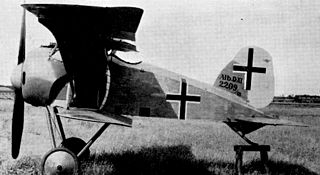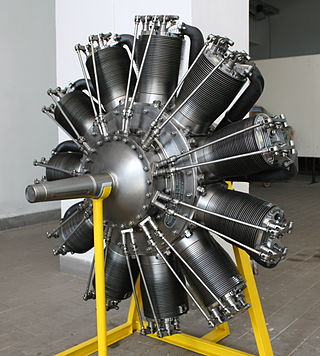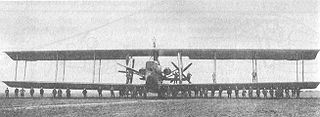
An aircraft constructed with a push-pull configuration has a combination of forward-mounted tractor (pull) propellers, and backward-mounted (pusher) propellers.

Siemens-Schuckert was a German electrical engineering company headquartered in Berlin, Erlangen and Nuremberg that was incorporated into the Siemens AG in 1966.

The Siemens-Schuckert D.IV was a late-World War I fighter aircraft from Siemens-Schuckert (SSW). It reached service too late and was produced in too few numbers to have any effect on the war effort.

The Albatros D.XI was a German single-seat fighter sesquiplane first flown in February 1918. It was the first Albatros fighter to use a rotary engine, in the form of the 120 kW (160 hp) Siemens-Halske Sh.III, and also featured a new wing construction with diagonal struts from the fuselage replacing traditional wire bracing.

The Siemens-Halske Sh.III was an 11-cylinder, air-cooled counter rotary engine developed in Germany during World War I. The engine was a development of the earlier 9-cylinder Siemens-Halske Sh.I.

The Siemens-Schuckert D.I was a single-seat fighter built by Siemens-Schuckert Werke in 1916. It was a German copy of the French Nieuport 17 that was obsolete by the time it was available in numbers, so that it served mainly as an advanced trainer.

The Blackburn Triplane was a single-engine pusher single-seater, designed specifically to attack Zeppelins. It flew in 1917, but was not successful.

The Siemens-Schuckert R.VIII was a bomber aircraft designed and built in Germany from 1916.

The Siemens-Schuckert D.VI was a single engine, single seat, parasol wing German fighter aircraft flown in 1919.
The Pfalz D.VII was a German biplane fighter aircraft from World War I. It was not put into production.

The LFG Roland D.IX was a World War I German single seat fighter aircraft, a biplane powered by one of a new generation of powerful rotary engines. Three slightly different prototypes were built but there was no series production.

The LFG Roland D.XVI, initially designated the LFG Roland E.I, was a single-seat, single-engine, parasol wing German fighter aircraft flown close to the end of World War I. Only two were built.

The LFG Roland D.XVII was a single-seat, single-engine, parasol wing German fighter aircraft flown close to the end of World War I. Only one was built.

The Albatros L.71 was a two-seat, single pusher engined biplane built in Germany in the 1920s.

The Siemens-Schuckert L.I was a large, three-engined biplane bomber aircraft, built in Germany towards the end of World War I. It was a twin boom design, strongly influenced by the successful Caproni Ca.3. Three were built but not used operationally.
The Siemens-Schuckert Dr.I was a German single seat triplane fighter aircraft first flown in 1917. Its development and that of a more powerful, uncompleted variant, was abandoned after a flight test programme.
The Siemens-Schuckert B was an unarmed German two seat reconnaissance biplane built early in World War I. A single example was delivered but soon lost.

The Lloyd 40.08 Luftkreuzer was a three engine triplane bomber type built during World War I. The design was proven to be ineffective and development did not proceed past the prototype stage.
The Euler Hydro-triplane was an unusual pusher configuration amphibious triplane flying boat, built in Germany in 1913.

The Raab-Katzenstein KL.1 Schwalbe (Swallow) was a German two-seat biplane produced in the 1920s. About fifty were built and the type became well known as an aerobatic aircraft, performing at many displays in the hands of pilots like Gerhard Fieseler.

















